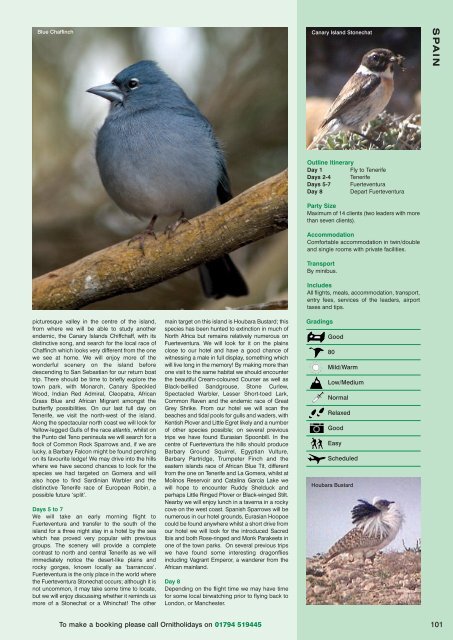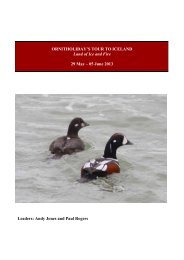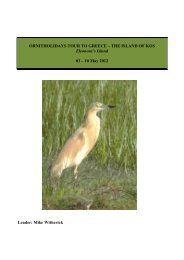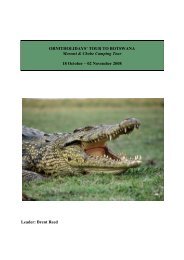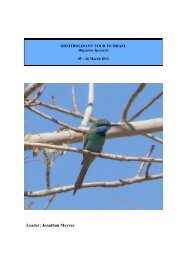Download 2014 Brochure (.pdf) - Ornitholidays
Download 2014 Brochure (.pdf) - Ornitholidays
Download 2014 Brochure (.pdf) - Ornitholidays
Create successful ePaper yourself
Turn your PDF publications into a flip-book with our unique Google optimized e-Paper software.
Blue Chaffinch<br />
Canary Island Stonechat<br />
S PA I N<br />
Outline Itinerary<br />
Day 1 Fly to Tenerife<br />
Days 2-4 Tenerife<br />
Days 5-7 Fuerteventura<br />
Day 8 Depart Fuerteventura<br />
Party Size<br />
Maximum of 14 clients (two leaders with more<br />
than seven clients).<br />
Accommodation<br />
Comfortable accommodation in twin/double<br />
and single rooms with private facilities.<br />
Transport<br />
By minibus.<br />
Includes<br />
All flights, meals, accommodation, transport,<br />
entry fees, services of the leaders, airport<br />
taxes and tips.<br />
picturesque valley in the centre of the island,<br />
from where we will be able to study another<br />
endemic, the Canary Islands Chiffchaff, with its<br />
distinctive song, and search for the local race of<br />
Chaffinch which looks very different from the one<br />
we see at home. We will enjoy more of the<br />
wonderful scenery on the island before<br />
descending to San Sebastian for our return boat<br />
trip. There should be time to briefly explore the<br />
town park, with Monarch, Canary Speckled<br />
Wood, Indian Red Admiral, Cleopatra, African<br />
Grass Blue and African Migrant amongst the<br />
butterfly possibilities. On our last full day on<br />
Tenerife, we visit the north-west of the island.<br />
Along the spectacular north coast we will look for<br />
Yellow-legged Gulls of the race atlantis, whilst on<br />
the Punto del Teno peninsula we will search for a<br />
flock of Common Rock Sparrows and, if we are<br />
lucky, a Barbary Falcon might be found perching<br />
on its favourite ledge! We may drive into the hills<br />
where we have second chances to look for the<br />
species we had targeted on Gomera and will<br />
also hope to find Sardinian Warbler and the<br />
distinctive Tenerife race of European Robin, a<br />
possible future ‘split’.<br />
Days 5 to 7<br />
We will take an early morning flight to<br />
Fuerteventura and transfer to the south of the<br />
island for a three night stay in a hotel by the sea<br />
which has proved very popular with previous<br />
groups. The scenery will provide a complete<br />
contrast to north and central Tenerife as we will<br />
immediately notice the desert-like plains and<br />
rocky gorges, known locally as ‘barrancos’.<br />
Fuerteventura is the only place in the world where<br />
the Fuerteventura Stonechat occurs; although it is<br />
not uncommon, it may take some time to locate,<br />
but we will enjoy discussing whether it reminds us<br />
more of a Stonechat or a Whinchat! The other<br />
main target on this island is Houbara Bustard; this<br />
species has been hunted to extinction in much of<br />
North Africa but remains relatively numerous on<br />
Fuerteventura. We will look for it on the plains<br />
close to our hotel and have a good chance of<br />
witnessing a male in full display, something which<br />
will live long in the memory! By making more than<br />
one visit to the same habitat we should encounter<br />
the beautiful Cream-coloured Courser as well as<br />
Black-bellied Sandgrouse, Stone Curlew,<br />
Spectacled Warbler, Lesser Short-toed Lark,<br />
Common Raven and the endemic race of Great<br />
Grey Shrike. From our hotel we will scan the<br />
beaches and tidal pools for gulls and waders, with<br />
Kentish Plover and Little Egret likely and a number<br />
of other species possible; on several previous<br />
trips we have found Eurasian Spoonbill. In the<br />
centre of Fuerteventura the hills should produce<br />
Barbary Ground Squirrel, Egyptian Vulture,<br />
Barbary Partridge, Trumpeter Finch and the<br />
eastern islands race of African Blue Tit, different<br />
from the one on Tenerife and La Gomera, whilst at<br />
Molinos Reservoir and Catalina Garcia Lake we<br />
will hope to encounter Ruddy Shelduck and<br />
perhaps Little Ringed Plover or Black-winged Stilt.<br />
Nearby we will enjoy lunch in a taverna in a rocky<br />
cove on the west coast. Spanish Sparrows will be<br />
numerous in our hotel grounds, Eurasian Hoopoe<br />
could be found anywhere whilst a short drive from<br />
our hotel we will look for the introduced Sacred<br />
Ibis and both Rose-ringed and Monk Parakeets in<br />
one of the town parks. On several previous trips<br />
we have found some interesting dragonflies<br />
including Vagrant Emperor, a wanderer from the<br />
African mainland.<br />
Day 8<br />
Depending on the flight time we may have time<br />
for some local birwatching prior to flying back to<br />
London, or Manchester.<br />
Gradings<br />
Good<br />
80<br />
Mild/Warm<br />
Low/Medium<br />
Normal<br />
Relaxed<br />
Good<br />
Easy<br />
Scheduled<br />
Houbara Bustard<br />
To make a booking please call <strong>Ornitholidays</strong> on 01794 519445<br />
101


